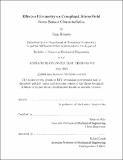Effects of geometry on compliant, stress field force sensor characteristics
Author(s)
Romero, Juan (Juan Andrés)
DownloadFull printable version (9.199Mb)
Other Contributors
Massachusetts Institute of Technology. Department of Mechanical Engineering.
Advisor
Sangbae Kim.
Terms of use
Metadata
Show full item recordAbstract
This thesis details the development and characterization of multiple geometries for compliant, stress field (SF) force sensors. The goal of exploring these different sensor designs is to begin identification of the geometric properties of SF force sensors that are most optimal for certain loading conditions. This work prioritizes robotic locomotion as the qualifying loading condition, with some considerations towards human locomotion. The stress field force sensors are comprised of a protected array of piezoelectric pressure sensor elements, embedded in an elastomer body. The geometric properties considered are orientation of the sensor elements, and shape and size of the elastomer body. In previous work, cylindrical stress field force sensors were developed and characterized for use in a force sensing smart-shoe. A material model for the elastomer used was also found. Depending on the geometry chosen, voltage values reported by the piezoelectric sensor elements are able to be resolved into forces along three axes, torques about the non-normal axes, and ground contact angle. This computation is done using linear and nonlinear methods, notably linear regression to determine coefficients for force and angle estimator functions and the use of least squares artificial neural networks (LSANN), respectively. The SF force sensors are manufactured using methods developed by Meng Yee (Michael) Chuah of the MIT Biomimetic Robotics Laboratory (BRL). These SF force sensors are able to measure forces over several orders of magnitude, ranging from 10-2 to 103 N depending on the geometric properties of the sensor. Certain SF force sensor geometries provide different outcomes in terms of accuracy, sensitivity, maximum loading, torque measurement, and contact angle measurement. For example, sensors with decreased thickness displayed increased ability to measure smaller forces, and sensors that have outwardly cylindrical elastomer layers are capable of estimating torques. Additionally, of the SF force sensor geometries explored, sensors with hemispherical elastomer shapes had a lower (2-4%) root mean squared (RMS) error in both normal and shear force directions, and were most capable of measuring roll angles. These outcomes will be further detailed in this paper. The creation of these footpad sensors are a part of ongoing work aimed at developing low-cost, durable force sensors for use in the locomotion of dynamic robots. These force sensors would be beneficial in aiding robotic pose estimation and contact detection, thereby allowing traversal of more variable terrain. Implementation of these SF force sensor geometries was conducted by measuring standing and walking forces of the MIT Cheetah 3 quadruped robot and the little HERMES biped robot while each was outfitted with SF force sensing feet. Accurate normal force and roll angle estimates were able to be produced for hemispherical SF force sensors attached to Little HERMES. The MIT Cheetah 3 quadrupedal robot posed challenges to establishing a reliable force comparison. However, the SF force sensors (error of -17 N in flight) performed better then the Cheetah's proprioception (error of ±150 N in flight) when it came to distinguishing between stance and flight. It is postulated that this is due to decreased susceptibility to inertial noise. Future iterations of the SF force sensors developed in this thesis could enable legged robots to have more robust force measurement and pose estimation when undergoing dynamic locomotion. Such capabilities could allow legged robots to achieve performances matching those of animals and take on complex tasks to the benefit of our society.
Description
Thesis: S.B., Massachusetts Institute of Technology, Department of Mechanical Engineering, 2018. This electronic version was submitted by the student author. The certified thesis is available in the Institute Archives and Special Collections. Cataloged from student-submitted PDF version of thesis. Includes bibliographical references (pages 91-92).
Date issued
2018Department
Massachusetts Institute of Technology. Department of Mechanical EngineeringPublisher
Massachusetts Institute of Technology
Keywords
Mechanical Engineering.